Almost 9 months ago, I promised you to write about my experience of living in one of New Zealand’s most remarkable communities – Tui. Then life happened and swept me onto new adventures and I forgot all about it. But as Tui is turning 30 this year, they have asked friends of the community to write a little something for the occasion and I realized that this was my chance to both give them my story and redeem myself to you, dear reader…
Here is what I sent to the Tuis:
My name is Cornelius and I am a Danish globetrotter and community enthusiast who first learnt about community-living in the 1000-people strong Freetown of Christiania – a famous and controversial community in the middle of Copenhagen. From small grungy squats to large scale utopian projects around the world, I have since visited and studied a great deal of communities. Some of them – like Tui – I visited for the purpose of making a radio documentary. My focus with this is to document intentional communities that are long-standing and non-religious, in an attempt to uncover what makes an alternative and individually diversified community last through the generations, without succumbing to the all-too-common problems of fanaticism, commercialism and inter-personal conflict.
Stumbling Upon A Gem
I was hitch-hiking near Nimbin in Australia, when I first heard of Tui, A lady who picked me up, turned out to be a fellow community aficionado and I told her about my community documentary project and that my next destination was New Zealand. Her response was to tell me about one of Tui’s founding members, Robina McCurdy, who happened to have just visited the Nimbin area to give a talk about permaculture. She then told me about Tui community and I decided then and there to visit the place, as soon as I got to New Zealand.
My second impression of Tui came from their website. I was curious to know a bit more about the community, and keen to arrange for me to stay there for a while, so I tried googling them. Having seen so many unkempt community websites over the years, I was very impressed with Tui’s home in cyberspace. Here was a community that, not only updated their website more than once every couple of years, they had also posted relevant information and up-to-date contact details!
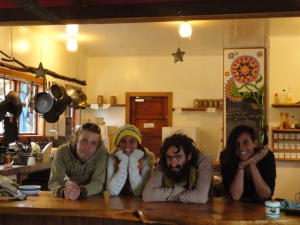
Me and my favourite three co-wwoofers; Ine, the Beast & Mari. A very special time that was for 4 strangers turned family.
I wrote to Tyson, the current (excellent!) visitor coordinator, and told him that I was hoping to do some work, in exchange for a few weeks of accommodation and possibly some food. I also wrote that I was interested in conducting a few interviews for my community documentary. Little did I know that I was going to spend 3 whole months there, working for the community as well as nearly every household, doing more than 20 interviews and no doubt winning some genuine friends for many years to come!
A Wwoofer Moves In And Up!
Spring had just started when I arrived in Tui and the group of community wwoofers, which I was a part of, were happy that there was still firewood for the cold evenings. The land and the people were coming out of hibernation and getting ready for the summer season. Crops were being sowed, roads and pathways prepared for a new busy-season. Projects and events were being planned and houses and sheds were getting a thorough cleaning.
We were installed in the large and comfortable homestead – the hub of Tui community. For a wwoofer it is a rare thing indeed to have your own room and with full access to the leisure room and the fully equipped, large kitchen, wwoofing at Tui felt more like being a part of the place, rather than being a visitor. The well stocked organic food “shop” that is run communally, and at cost-price, plus the lush vegetable garden, also made for an enjoyable and tasty stay where I felt my health improve by the day!
Much to my relief, I found that there was much work to be done and that wwoofing wasn’t the only way to roll. I had arrived in New Zealand with very little money, in the hope that I would be able to sustain myself through working as a carpenter and landscaper. In Tui, it was clear that these skills were much sought after, leading me to think that there was, perhaps, a shortage of young and able-bodied community members.
Anyhow, when my tenure as a community wwoofer was over, I continued as Tyson’s personal wwoofer until I eventually got hired as the overseer for a 3-week wwoofing project establishing the new community garden – I was moving up in life!
Getting The Next Generation Going
As a documentary maker, I was eager to find out how Tui might have overcome the dreaded age-gap that many communities face when the first generation of children leave the nest to explore the world, leaving behind an ageing group of pioneers.
As it turned out, this had indeed been the scenario in Tui, and many a meeting had revolved around this issue. The result was an imposed age-limit of around 40 years for any newcomers, a limit that was more of a guideline than a rigid rule, as it were. However, the strategy seemed to work because by the time I got to Tui, there was a whole new generation of children being reared by their young and enthusiastic parents – most of them new or prospective members.
I even got to witness a young family with 3 kids move into Tui, so there is little doubt that Tui has passed the critical threshold of perpetuating itself into the future – at least for another generation. So, when I thought there was a shortage of younger people to “work the land” I was only partially right; there were plenty of young people there, comparatively, but with each young family having kids to rear and incomes to be made, there was still a need for more hands on deck, so to speak.
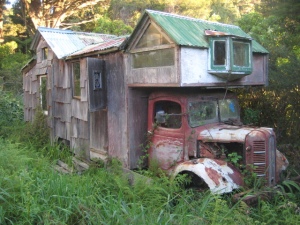
An old house truck tells its own story of pioneering days at Tui. These days it functions as an awesome guest house.
Show Me Some Trouble!
Points of conflict often makes for a good story and they can help to shed some light on various issues and challenges that a community might face. Usually I haven’t had any problems finding conflict in intentional communities, as meetings are often rife with grievances and politics.
Sometimes community meetings can be veritable verbal battlefields, with one nasty utterance spawning the next, but in Tui I found nothing of the sort. Beyond some disagreement and the odd bit of gossiping and bickering (outside of meetings), I actually had a hard time digging up any dirt about the community.
I would often pose the question if Tui was really so harmonious as it seemed, or if I was just being spared for the worst interactions? The answers were all very similar: I had come at a very opportune time for Tui, as things were going smoother than they had for many years.
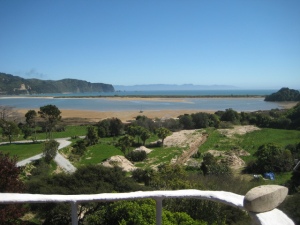
A view from the hills over some of Tui’s flatlands. The huge piles of sand are a reminder of the flood that shifted both earth and energy around.
Several of the Tuis told me that the devastating flood a few years back, had contributed to the present cohesiveness and harmony in the community. Facing a common challenge and having to rely on each other for the restoration and clean-up, had apparently been a strong bonding experience and provided an opportunity for everyone to contribute their skills and mutual support.
Much had been lost, not least the 25-year-old community garden – a focal point for communal interaction. Yet, at the same time, I was told, the raging waters had also cleaned out a lot of stagnant energy on the land itself and made way for a better flow in the metaphysical realm of things.
Of course everybody had their own pet issue, that they felt strongly about and wanted change within, but on the whole I found that the Tuis were quite content and even happy! Seeing that (at least in my book) one of the main aims of establishing a community is to create a happy space to live in, I could only conclude that Tui seemed like a very successful community indeed.

I had the honour of looking after one of the best views in Tui for a few days. It’s hard to be upset or uptight when you live in a place like this!
Cult Or Cultivation?
Tui Community is owned by a trust, the so-called “Tui Spiritual and Educational Trust”. During my interviews with Tui’s about 25 adult community members, a standard question I would ask was always; “What makes Tui a spiritual community for you?”. The answers were many but most of them revolved around interactions between the Tuis and the spirit of the land itself.
The sheer beauty of the area where Tui is located, obviously lends itself to contemplation and a sense of connection with nature, but I was intrigued to find out more about the spiritual practices of the Tuis. Could it be that they didn’t fit my criteria of being non-religious after all?
The short answer was no. Although I found every member of Tui to be rather spiritually inclined and although there are several shared practices that are spiritual in nature (i.e. celebrating equinox & solstice), I also found that there was no pressure whatsoever to be involved in these activities and that every individual in Tui is free to believe or practice whatever they fancy.
Overall, though, I found that there is a shared notion of spiritual connection between the people and the land. This sentiment is even reflected in the legal structure of Tui, whereby the members do not individually own the land but merely act as conscientious stewards of this beautiful corner of the world.
Welcome To The Meeting
One thing that appears to be common to every member of Tui, though, is an interest in personal growth. To me, that became apparent in the way they run their meetings. First of all, there is (mostly) no voting involved. Whatever issue arises is discussed at length until everyone is heard or until an agreement is reached.
Despite some – at times strong – disagreements, I never felt that anyone was being bullied, coerced or ridiculed. For such a high level of mutual understanding to be exercised, it takes every individual’s commitment to put their community relations first and their egos last.
Also, the Tui community meetings are open to anyone who happen to be around. This is a big difference from other community meetings I have experienced, where outsiders are generally not really welcomed in at meetings unless they are part of the meeting agenda somehow.
In Tui, however, wwoofers and guests are free to listen in, even when “hot” topics are discussed and emotions run high. I found that very beautiful and even admirable. For a community to expose its problems and processes to strangers like that, it must be strong and confident about itself and its cohesive ability.
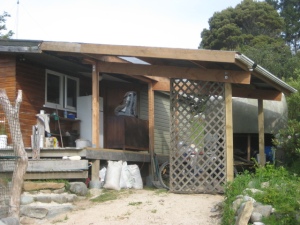
In my capacity of Master of Lean-To’s I left behind no less than three new covered spaces. Tyson’s new carless carport no doubt takes the price, however.
Getting My Shirt Dirty
Most documentary makers will attempt to keep an emotional distance to their subject, so as not to become biased and one-eyed. I cannot exactly say that this is my approach. To begin with I am already a strong proponent of intentional communities, but more so than that, I naturally can’t help but become a part of the place and the people when I visit a community. As it happens, this often makes for a unique and first-hand opportunity to experience the inner workings of a community.
In the case of Tui, I nearly thought I had gotten myself into a bit of a mess, but as described above, the Tuis have cultivated a high level of understanding and ability to defuse situations that could otherwise easily become a point of conflict. And yes, of course, it had to do with lovers new and old!
Tyson, my main contact and wwoofing host, has a child (the amazing Kiva) with beautiful Inna, the current chairperson of the Tui Trust, whom I had a keen eye to from the moment I saw her. Knowing their background, however, I felt it was best that I stayed out of any potential love story on that front, but as we all know, the way of the heart cannot be led by logic…
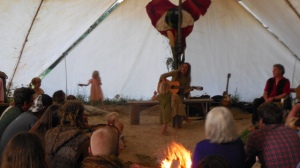
Beautiful Inna plays a rainbow song at a Tui wedding party while her sweet daughter Kiva makes a spontaneous dance.
I soon realized, however, that there was indeed no reason to worry. Of course, Tyson and Inna were no longer partners in any case, but it wouldn’t have been a world-first if I’d ended up in the middle of an ex-lover drama. What ensued instead was much more like a relaxed comedy than a tense drama.
As it happened, Tyson found it pretty hilarious that Inna had “snatched” his wwoofer and the whole story opened up for a number of conversations on the subject of “partner-swaps” and open relationships throughout the history of Tui. Unintended as this was, it was priceless for my understanding of Tui.
Now, as you can imagine, there has been plenty of unconventional love stories in this small community, where new ideas are tried and tested and where following the heart is a high priority. I’m sure it hasn’t always been without frustration and broken dinner plates, but at this point in Tui’s history, what I found was a community that collectively resisted the very human urge to gossip and make a feather into five hens, as the saying goes.
Rather than create strife and drama, I saw that here is a group of people who simply observe whatever situation might arise and offer their help without judgement but with plenty of humour! In other words; I saw respect, empathy and support for everybody’s choices and circumstances. And to this day I gratefully count both Inna and Tyson as my good friends as well as several other of Tui’s members.
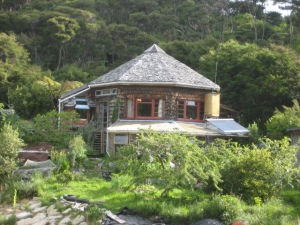
A Czech guy built this incredible 8-sided house with wooden shingles on the roof and a real fantasy-feel to the whole structure.
Taking The Time It Takes
As anyone who has visited Tui will know, the Tui Treefield or Events Park is a pivotal part of the community. It is testament to the vision and dedication of Tui’s early pioneers that this, once barren field, now holds a veritable forest with an array of inventive and beautifully crafted structures, perfectly set up for large events.
This is where Tui’s so-called Tukis are held. You see, for any group of people to get along, there must be time and space for communication that goes deeper than the everyday practicalities of life. Beyond weekly community meetings and monthly board-of-trustee meetings, Tui has therefore devised something that is more of a “sharing” than a meeting – this is the Tuki.
Three times a year, the Tuis thus take off a whole weekend for discussing issues or topics that are not easily dealt with at the regular meetings, i.e. when they decided to impose an age-limit for new members to overcome the challenge of an ageing population. But before they get to the nitty-gritty of such momentous debates, they apply the ancient talking-stick method of forming a circle and letting every single member express to the rest of the community how they feel at that point in time; how their current life-situation is and whatever else they feel needs expressing.
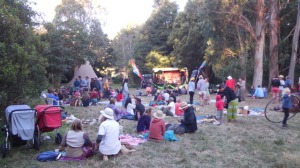
A snap from the Delight Festival held at the Treefield. To think that 30 years ago there was nothing but sand and grass here…
Needless to say these “sharings” are incredibly personal and heartfelt, albeit occasionally long-winded as some of the Tuis confessed to me. However, everyone accepts the effort it takes to form a strong bond as a community and willingly puts in the time it takes to hear everyone out.
Being only a visitor, I obviously didn’t participate in the Tuki that was held while I was there (I ended up babysitting all of the wonderful and cheeky kids instead, talk about joyful exhaustion) but I have no doubt that the Tukis are key to the success and integrity of Tui. This practice is definitely something that I will try and implement in future communities I might be part of.
A Better Way Of Growing Up
Apart from the Tukis, the occasional community party, wedding or festival, the Treefield is also home to the pioneering work of Tracks & Tides, which is a serious and thorough re-introduction of the ancient rites of passage from adolescence into adulthood. This is a practice that most Western cultures have all but lost; a practice that is meant for preparing our youngsters for the challenges and joys of adult life by imparting wisdom and life-experience from one generation to the next.
Using a variety of methods like role-play, story-telling and outdoor living, and taking sometimes a whole week to complete, these gender-partitioned events (Tracks for boys, Tides for girls) create a kind of safe space for parents and their offspring to relate in new ways that promote mutual respect and a responsible attitude to life.
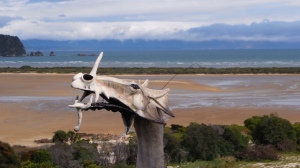
Tracks & Tides organizer Jim’s famous dragon chimney can be seen from afar and is a landmark for Tui. It was, in fact, supposed to have been a large penis, but the neighbours weren’t that hooked on that idea. Oh Jim!
I was blown away when I heard of this work and my first reactions were a mixture of scepticism and pangs of envy: Why hadn’t I had this opportunity as a young man? Here was something so ancient and sensible and yet so unfamiliar to me that I first wrote it off as New Age indoctrination.
In the spirit of these gender-obsessed times, I immediately posed the question whether the strict separation wasn’t just propagating gender stereotypes? The question, I am afraid, was too simple for the answer I got. First of all, talking about sexuality is obviously a huge part of these rites and anyone who remembers how being a teenager felt like, will acknowledge the difficulty (not to mention the differences) with which this subject is discussed when girls and boys in their puberty are in the same group.
Furthermore, I was told, homosexuality or any form of non-normative gender identification/attraction is always something that is talked about as a perfectly normal topic, for instance in the story-telling sessions where adults, straight and gay, relay their life stories as real examples of valuable lives lead.
The more I spoke to organizers and participants alike, the more my respect and fascination grew. If anything, this kind of ritual is a very tangible way of creating positive change in the world by shaping the generations to come, into a more conscious and caring crop. Not least some of the teens who had gone through these rites (of which the first generation have now become adults in their own right) convinced me with their stories of how it had impacted them, that this is both important and highly viable work.
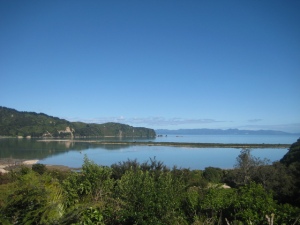
Being in Tui really is like walking into one postcard after the next. Just stunning views everywhere you look. I certainly too felt the spirit of the land; gentle, soothing, healing. Arriving with a broken heart, I left Tui again with appetite for life and renewed trust in myself.
Final Inspiration & Gratitude
Perhaps my documentary project or my many years of experience with community living gave me a “step up” in terms of being invited into the homes of the Tuis and getting a thorough introduction into the inner workings of their community. Whatever the reason, my impressions were many and varied and almost exclusively positive.
I had so many experiences in Tui that proved to me what a high level of practical, social and individual understanding Tui and its members have reached over the course of three decades of community living and I can confidently say that Tui is one of the most well-functioning and harmonious intentional communities that I have come across in my travels so far.
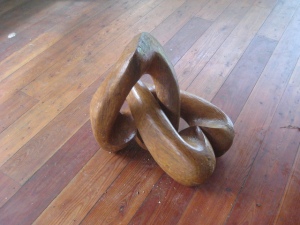
You are looking at two wooden hearts, carved from the same block. They move but are interconnected without any seams. Real craftsmanship, wonderful symbolism…
My stay in Tui has inspired me and educated me, like I am sure it has for the thousands of visitors and residents that Tui has hosted over the years. As I continue to live my life in community with like-minded people across the world, Tui has shown me that it is very possible and achievable to live the dream and stay true to the ideals of peace, love and understanding – for this earth, its plants and creatures and the human family that we share it with.
Thank you Tui and see you again.
Keep up the great work!
Your Friend
Cornelius
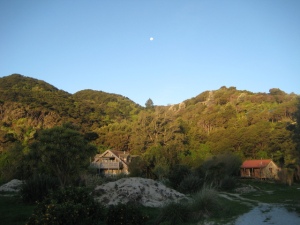
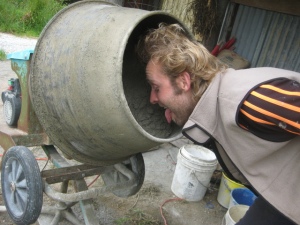
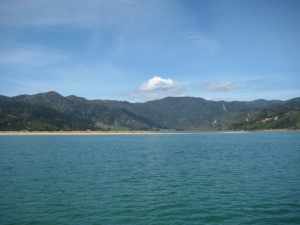
Jul 03, 2014 @ 22:39:03
Just beautiful!
Jul 14, 2014 @ 22:31:49
How delightful! Thank you, Cornelius! Cheerio